industries
industries
Introduction to Data Center Design: Fundamentals and Principles
By
Dr. Sudhakar Gummadi
—
min read



Introduction to Data Center Design: Fundamentals and Principles
Every time you stream a video, send an email, or check your bank balance, you're tapping into the power of a data center. But have you ever wondered what goes on behind those blinking lights and humming servers?
Welcome to the world of data center design. It's a place where cutting-edge technology meets careful planning, where every detail matters, and where the future of our digital lives is being shaped.
In this blog, we're going to pull back the curtain and give you a peek into the fascinating world of data center design. Whether you're a tech enthusiast, a business owner, or just curious about how the internet really works, there's something here for you.
Let's get started with the basics.
Our data centre consulting team can help you optimize your data centre design. Get in touch with us to know more.
Basics of Data Center Design
Think of a data center as a digital city. It needs power, cooling, security, and infrastructure to function. And just like a city, it needs careful planning to run smoothly.
What is Data Center Design and Why is it Important?
Data center design is the art and science of creating the perfect environment for data processing and storage. It's about more than just racks of servers. It's about creating a system that's efficient, reliable, and ready for the future.
Why is it important? Well, let's break it down:
Efficiency: Good design means your data center uses less power and runs more smoothly. That's good for your wallet and good for the planet.
Reliability: In the digital world, downtime is a dirty word. Proper design ensures your data center keeps running, no matter what.
Scalability: The only constant in tech is change. A well-designed data center can grow and adapt as your needs change.
Security: Data is valuable. Good design keeps it safe from both physical and digital threats.
Cost-effectiveness: Smart design can save you money in the long run, reducing operational costs and maximizing your investment.
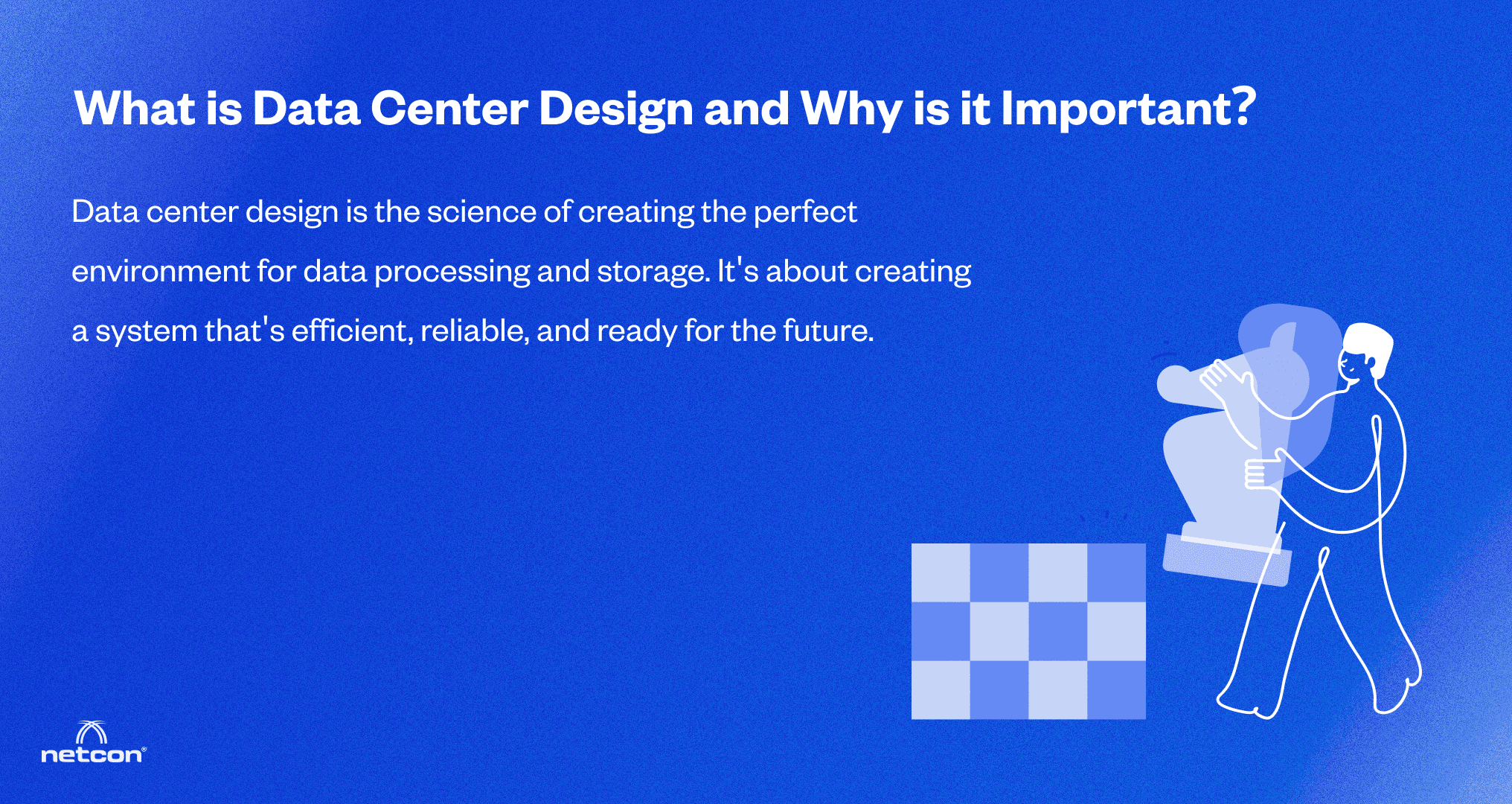
Think of data center design as the foundation of your digital operations. Get it right, and everything else falls into place. Get it wrong, and you're in for a world of headaches.
Principles of Effective Data Center Design
So, what makes for good data center design? Let's look at some key principles:
1. Flexibility: The tech world moves fast. Your data center needs to keep up. Design with flexibility in mind, so you can adapt to new technologies and changing needs.
2. Scalability: Start small, think big. Your data center should be able to grow with your business. Modular design is your friend here.
3. Efficiency: Power isn't free, and neither is cooling. Design for maximum efficiency to keep your costs down and your performance up.
4. Reliability: Downtime is expensive. Design for redundancy in all critical systems. If one component fails, another should be ready to take over.
5. Security: Data is your most valuable asset. Design your data center with multiple layers of security, both physical and digital.
6. Sustainability: Green is the new black. Design with the environment in mind. It's good for the planet and often good for your bottom line too.
7. Manageability: A data center shouldn't be a maze. Design for easy access and maintenance. Your future self (and your IT team) will thank you.
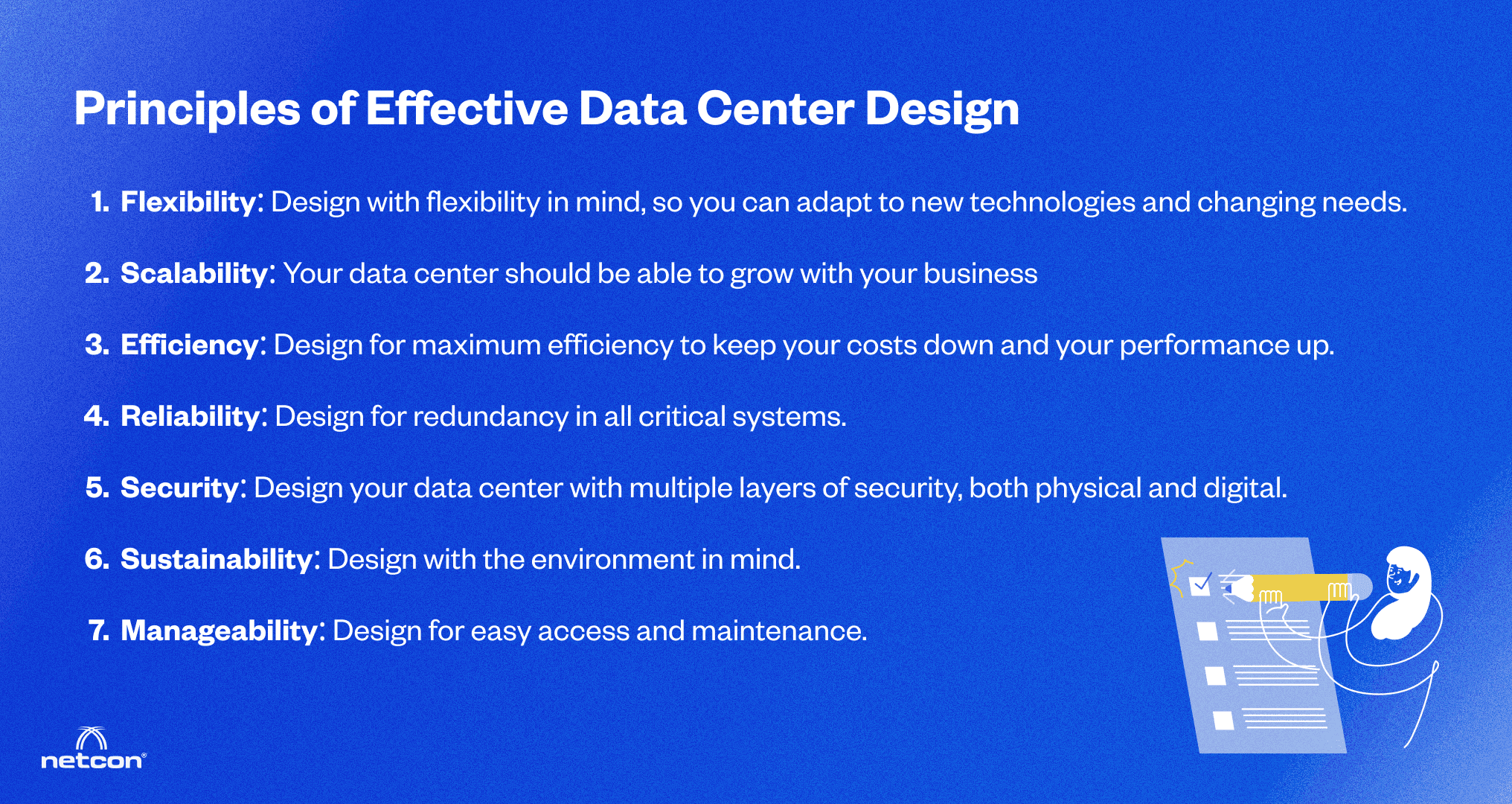
These principles aren't just theoretical. They're the difference between a data center that's a costly headache and one that's a powerful asset for your business.
Understanding the Basic Data Center Architecture
Now, let's take a look under the hood. What makes up a data center?
1. IT Equipment: This is the heart of your data center. Servers, storage systems, network devices - all the hardware that processes and stores your data.
2. Power Systems: Data centers are power hungry. You need reliable power supply, backup generators, and uninterruptible power supplies (UPS) to keep everything running.
3. Cooling Systems: All that equipment generates heat. Lots of heat. Cooling systems keep everything running at the right temperature.
4. Network Infrastructure: This is how your data center connects to the outside world. It includes routers, switches, and cabling.
5. Security Systems: Both physical (like access controls and surveillance) and digital (firewalls, intrusion detection systems).
6. Fire Suppression: Because nobody wants a barbecued server.
7. Monitoring Systems: To keep an eye on everything and catch problems before they become disasters.
But here's the thing: it's not just about having all these components. It's about how they work together. That's where design comes in.
Let's break down a typical data center layout:
Hot Aisle/Cold Aisle Configuration: This is a smart way to manage airflow. Server racks are arranged in alternating rows, with cold air intakes facing one way and hot air exhausts facing the other. It's like creating traffic lanes for your air conditioning.
Raised Floor: Many data centers use raised floors. The space under the floor can be used for cooling, power distribution, and cabling. It's like giving your data center a basement.
Overhead Cable Trays: Some modern designs are moving away from under-floor cabling and using overhead trays instead. It's easier to access and modify.
Separate Rooms: Most data centers have separate rooms for different functions. There might be a room for IT equipment, another for power systems, and another for cooling equipment. It's like giving each system its own apartment in your data center city.
Loading Dock: Often overlooked, but crucial. You need a way to get equipment in and out safely.
Network Operations Center (NOC): This is the control room of your data center. It's where monitoring and management happen.
Remember, this is just a basic layout. Every data center is unique, designed to meet specific needs and overcome specific challenges.
Data center design is a complex dance of technology, physics, and foresight. It's about creating an environment where your digital operations can thrive, grow, and adapt to whatever the future brings.

But here's the exciting part: we're just scratching the surface. The world of data center design is constantly evolving, with new technologies and approaches emerging all the time.
If you've already reached the next step and are designing your data center, this blog will give you insights and information that'll be valuable to you.
Types of Data Centers
Not all data centers are created equal. Just like cars come in different shapes and sizes for different needs, data centers come in various types. Each type has its own design considerations and is suited for specific purposes. Let's dive in and explore the world of data center diversity.
The Four Main Types of Data Centers Explained
1. Enterprise Data Centers
Think of these as the personal garages of the data center world. They're owned and operated by a single company for its own use.
Who uses them? Large corporations, government agencies, and universities often have their own enterprise data centers.
Design considerations:
- Tailored to the specific needs of the organization
- Often require high levels of security and compliance
- May need to support a wide range of applications and services
Pros:
- Full control over data and infrastructure
- Can be customized to exact specifications
- Often more cost-effective for very large organizations
Cons:
- Requires significant upfront investment
- Organization is responsible for all maintenance and upgrades
2. Colocation Data Centers
These are the apartment buildings of the data center world. Multiple companies rent space in the same facility, bringing their own IT equipment.
Who uses them? Small to medium-sized businesses, larger companies looking for additional capacity or disaster recovery options.
Design considerations:
- Need to accommodate diverse client requirements
- Must have robust security to keep different clients' data separate
- Require scalable power and cooling solutions
Pros:
- Lower upfront costs compared to building your own data center
- Shared infrastructure reduces operational costs
- Professional management and security
Cons:
- Less control over the facility
- Potential for noisy neighbors (other clients' operations affecting yours)
3. Hyperscale Data Centers
These are the skyscrapers of data centers. Massive facilities operated by tech giants to support cloud services.
Who uses them? Companies like Google, Amazon, Microsoft, and Facebook.
Design considerations:
- Enormous power and cooling requirements
- Need for extreme efficiency to manage costs
- Must be highly scalable to accommodate rapid growth
Pros:
- Economies of scale lead to high efficiency
- Cutting-edge technology and design
- Massive computing power and storage capacity
Cons:
- Requires enormous capital investment
- Complex to manage and maintain
- May face regulatory challenges due to their size and power consumption
4. Edge Data Centers
Think of these as the convenience stores of the data center world. Small facilities located close to the users they serve.
Who uses them? Content delivery networks, IoT applications, anyone needing low-latency data processing.
Design considerations:
- Must be compact and efficient
- Often need to operate with minimal on-site staff
- Require robust remote management capabilities
Pros:
- Reduces latency for time-sensitive applications
- Can improve performance and user experience
- Helps manage network congestion
Cons:
- Limited capacity compared to larger data centers
- Can be more expensive to operate due to distributed nature
- May face challenges in terms of physical security and maintenance
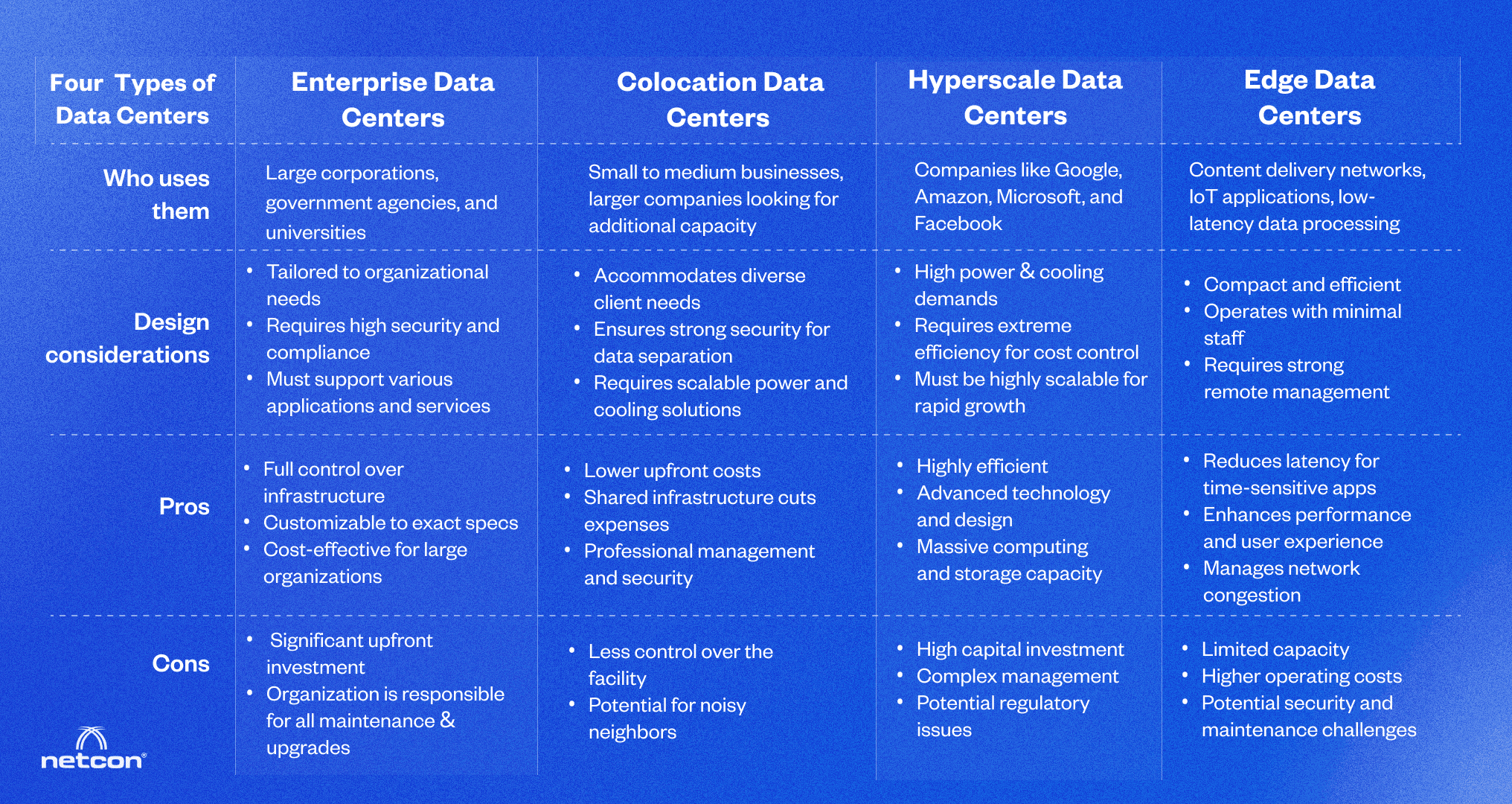
Each of these types has its place in the data center ecosystem. The right choice depends on your specific needs, budget, and long-term strategy.
Edge vs. Core Data Centers: Design and Functionality Differences
Now, let's zoom in on two types of data centers that are often compared: Edge and Core. These two represent different approaches to data center design and functionality.
Core Data Centers
Core data centers are the heavy lifters of the data world. They're typically large facilities located in strategic areas, designed to process and store vast amounts of data.
Design Characteristics:
- Large footprint: Often occupy thousands of square feet
- High capacity: Designed to handle massive amounts of data and computing power
- Robust infrastructure: Multiple layers of redundancy in power and cooling
- Centralized: Usually located in areas with good connectivity but not necessarily close to end-users
Functionality:
- Big data processing: Ideal for tasks that require lots of computing power
- Long-term storage: Often used for archiving large amounts of data
- Complex operations: Can handle resource-intensive applications and services
Edge Data Centers
Edge data centers are the sprinters of the data world. They're smaller facilities located closer to end-users, designed for speed and responsiveness.
Design Characteristics:
- Compact size: Often modular or containerized designs
- Distributed: Located in many locations, closer to users
- Efficient cooling: Often use innovative cooling solutions due to space constraints
- Standardized: Tend to use standardized designs for easy replication and management
Functionality:
- Low latency: Ideal for applications that need quick response times
- Local processing: Can handle data processing closer to where data is generated
- Content delivery: Often used to cache and deliver content more efficiently
Key Differences
1. Location and Distribution
Core: Centralized in fewer, larger locations
Edge: Distributed across many smaller locations
2. Size and Capacity
Core: Large facilities with high capacity
Edge: Smaller facilities with limited but focused capacity
3. Latency
Core: Can have higher latency due to distance from users
Edge: Designed for low latency, closer to users
4. Types of Workloads
Core: Suited for big data analytics, long-term storage, complex processing
Edge: Ideal for real-time processing, IoT applications, content delivery
5. Scalability
Core: Scales up (adding more capacity to existing facilities)
Edge: Scales out (adding more edge locations)
6. Management
Core: Often requires significant on-site staff
Edge: Designed for remote management with minimal on-site personnel
7. Cost Structure
Core: High upfront costs, economies of scale in operation
Edge: Lower individual facility costs, but can be more expensive to operate at scale
8. Power Usage
Core: High power usage, but often more efficient due to scale
Edge: Lower power usage per facility, but may be less efficient overall
9. Cooling Solutions
Core: Often uses traditional cooling methods due to available space
Edge: May require innovative cooling solutions due to space constraints
10. Network Architecture
Core: Hub of network architecture
Edge: Extends the network closer to users
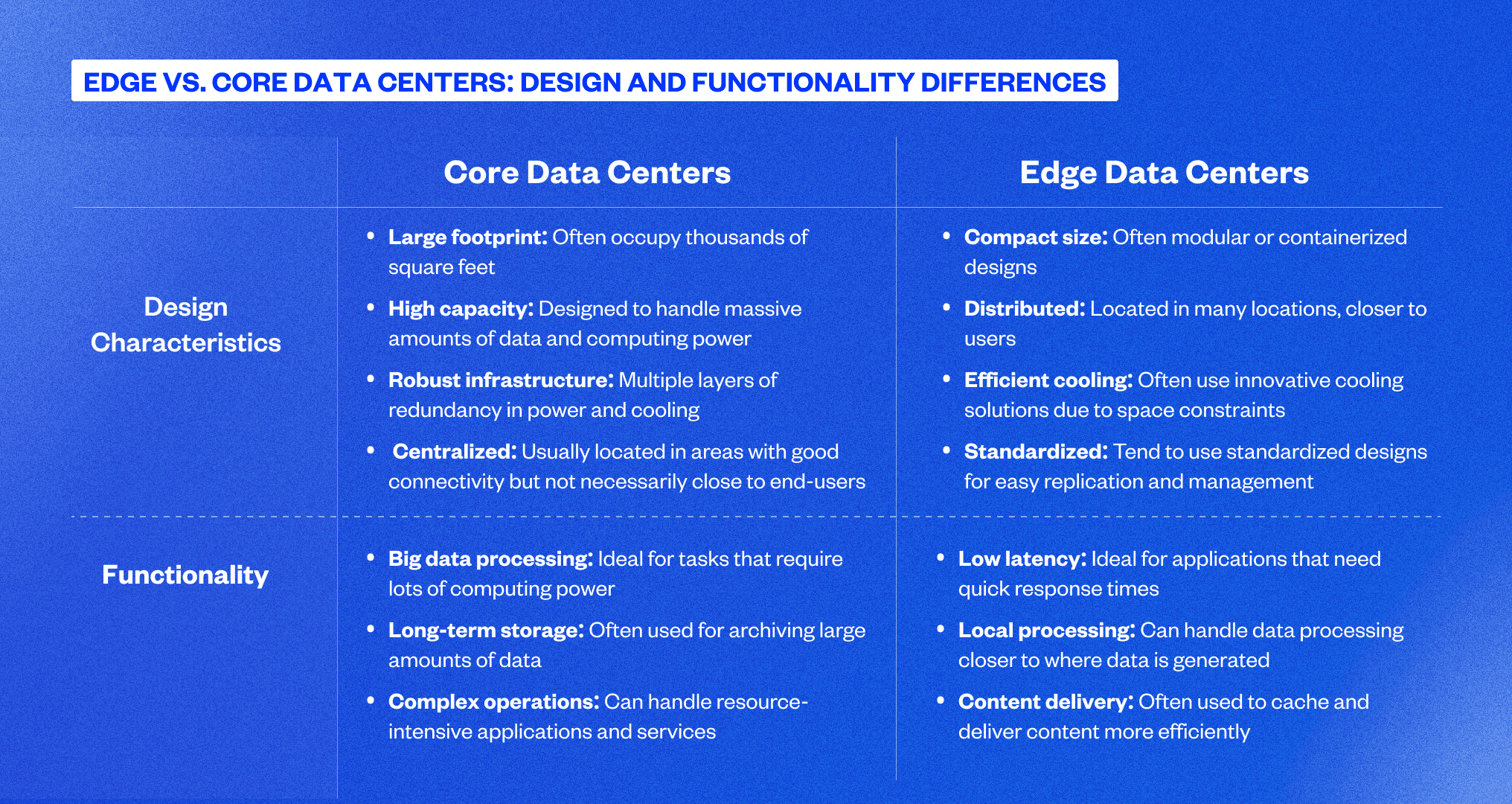
The choice between core and edge isn't always an either/or decision. Many organizations are adopting hybrid approaches, using both core and edge data centers to balance performance, cost, and functionality.
Edge computing is growing rapidly, driven by the need for low-latency processing and the explosion of IoT devices. But core data centers aren't going anywhere. They're evolving to handle the massive amounts of data generated by our increasingly digital world.
Understanding these different types of data centers is crucial for making informed decisions about your data infrastructure. Whether you need the raw power of a core data center, the responsiveness of edge computing, or a mix of both, the key is aligning your data center strategy with your business needs.
Need help figuring out what type of data center is right for you? Or maybe you're looking to optimize your existing data center infrastructure? That's where we come in. At Netcon Technologies, we specialize in helping businesses navigate the complex world of data center design and strategy.
Ready to take the next step in your data center journey? Let's talk. Our team of experts is ready to help you find the right data center solution for your unique needs. Get in touch today, and let's start building your data future.
Standards and Best Practices in Data Center Design
In the world of data centers, flying by the seat of your pants isn't an option. Standards and best practices are the guardrails that keep data center design on track. They're the distilled wisdom of countless professionals who've been there, done that, and learned the hard way.
Let's dive into these standards and best practices. They're not just bureaucratic red tape - they're your roadmap to a better, more efficient data center.
Overview of Data Center Design Standards
Standards in data center design aren't just suggestions. They're the benchmark for quality, reliability, and performance. Let's look at some of the key players in the standards game.
1. Uptime Institute Tier Standards
The Uptime Institute's Tier Classification System is the gold standard in data center reliability. It defines four tiers:
Tier I: Basic Capacity
- Single path for power and cooling
- No redundant components
- 99.671% availability
Tier II: Redundant Capacity Components
- Single path for power and cooling
- Redundant components
- 99.741% availability
Tier III: Concurrently Maintainable
- Multiple paths for power and cooling
- Redundant components
- 99.982% availability
Tier IV: Fault Tolerant
- Multiple active paths for power and cooling
- Redundant components
- 99.995% availability
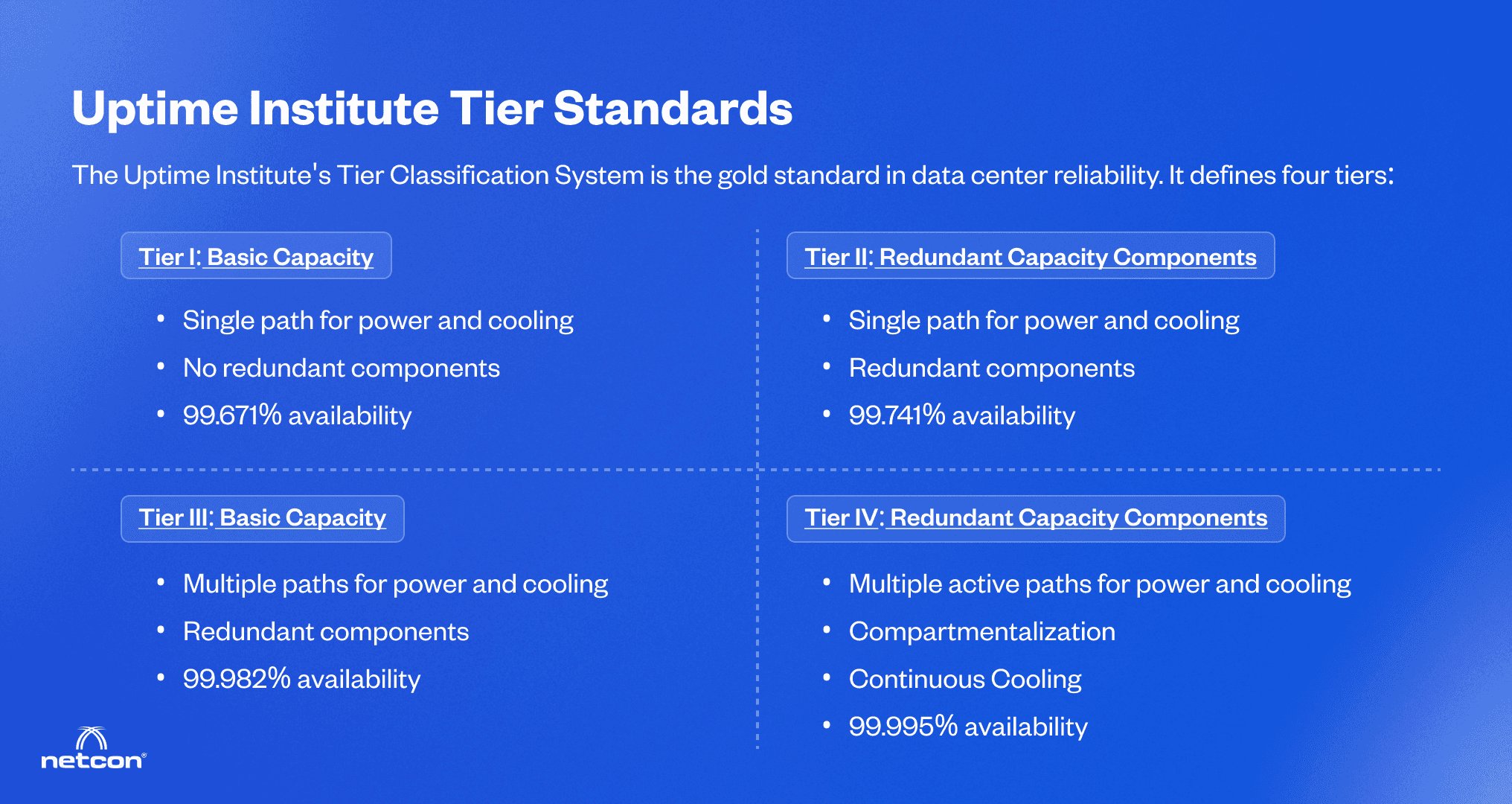
Each tier builds on the previous one, adding layers of redundancy and reliability. But remember, higher tiers come with higher costs. It's about finding the right balance for your needs.
2. TIA-942
This standard from the Telecommunications Industry Association covers everything from site selection to network architecture. It aligns with the Uptime Institute tiers but goes into more detail on telecom infrastructure.
Key areas covered:
- Site space and layout
- Cabling infrastructure
- Reliability levels
- Environmental considerations
3. BICSI 002
The Building Industry Consulting Service International (BICSI) standard is like a detailed cookbook for data center design. It covers:
- Site and space planning
- Power systems
- Cooling systems
- Security
- Network systems
It's particularly useful for its sections on emerging technologies and sustainable design practices.
4. ISO/IEC 22237
This international standard is all about availability, security, and energy efficiency. It's divided into several parts, each focusing on a different aspect of data center design and operation.
Key areas:
- Building construction
- Power distribution
- Environmental control
- Telecommunications cabling infrastructure
- Security systems
5. EN 50600
This European standard is similar to ISO/IEC 22237 but with a European focus. It's particularly strong on energy efficiency and environmental sustainability.
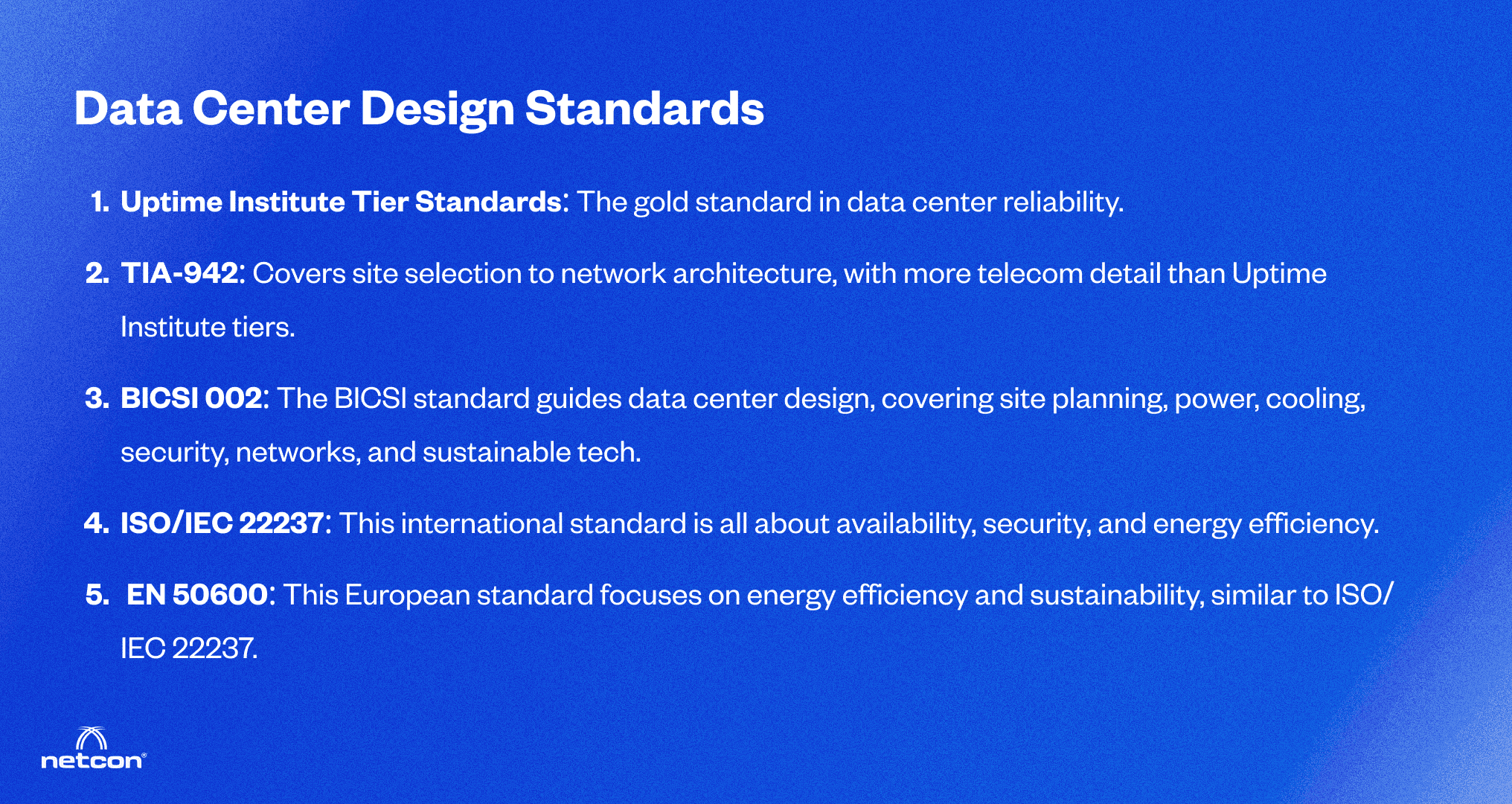
These standards aren't just arbitrary rules. They're based on years of experience and best practices. They help ensure that your data center is reliable, efficient, and ready for the future.
Advanced data center design is the reason behind optimized and well-managed data centers. Read to know more.
Best Practices for Modern Data Center Layout and Infrastructure
Now that we've covered the standards, let's look at some best practices. These are the tricks of the trade that can take your data center from good to great.
1. Modular Design
Think Lego, not monolith. A modular approach allows for:
- Easier scaling
- Phased deployment
- Standardization across multiple sites
Best practice: Design your data center in standardized modules that can be easily replicated or expanded.
2. Hot Aisle/Cold Aisle Configuration
This isn't just a good idea - it's essential for efficient cooling.
How it works:
- Server racks are arranged in alternating rows
- Cold air intakes face one aisle, hot air exhausts face the other
- Containment systems can further improve efficiency
Best practice: Implement hot aisle/cold aisle with containment for maximum cooling efficiency.
3. Right-Sizing
Overprovisioning is costly. Under-provisioning leads to problems down the line.
Best practice: Use data center infrastructure management (DCIM) tools to accurately predict and plan for capacity needs.
4. High-Density Zones
Not all areas of your data center need the same level of cooling or power.
Best practice: Create designated high-density zones for power-hungry equipment, allowing for more targeted cooling and power distribution.
5. Raised Floors vs. Overhead Infrastructure
The debate rages on, but the trend is moving towards overhead infrastructure.
Pros of overhead:
- Easier access for maintenance
- Better for non-uniform rack heights
- Can be more efficient for cable management
Best practice: Consider overhead infrastructure for new builds, but weigh the pros and cons for your specific situation.
6. Liquid Cooling
As power densities increase, air cooling is reaching its limits.
Best practice: For high-density racks (20kW and above), consider liquid cooling solutions.
7. Renewable Energy Integration
Green isn't just good PR - it can also be good for your bottom line.
Best practice: Explore on-site renewable energy options like solar panels or fuel cells, and consider power purchase agreements (PPAs) for off-site renewable energy.
8. AI and Automation
The data center of the future is smart and self-managing.
Best practice: Implement AI-driven management systems for predictive maintenance, energy optimization, and capacity planning.
9. Edge Integration
Edge computing isn't replacing core data centers - it's complementing them.
Best practice: Design your core data center with edge integration in mind. Plan for how data will flow between edge sites and your core facility.
10. Future-Proofing
The only constant in tech is change.
Best practice: Design flexibility into your data center. Use adaptable infrastructure that can accommodate new technologies as they emerge.
11. Security by Design
Security shouldn't be an afterthought.
Best practice: Implement a multi-layered security approach, including physical access controls, surveillance, and cybersecurity measures.
12. Efficient Power Distribution
Power is the lifeblood of your data center. Use it wisely.
Best practice: Implement high-efficiency UPS systems, consider DC power distribution for certain applications, and use intelligent PDUs for granular power monitoring and control.
13. Cable Management
Messy cables aren't just unsightly - they can impede airflow and make maintenance a nightmare.
Best practice: Implement a structured cabling system with clear labeling and routing. Consider fiber optics for high-speed connections.
14. Scalable Cooling
Your cooling needs will change as your data center grows.
Best practice: Implement a scalable cooling system that can adapt to changing heat loads. Consider free cooling where climate permits.
15. Environmental Monitoring
You can't manage what you don't measure.
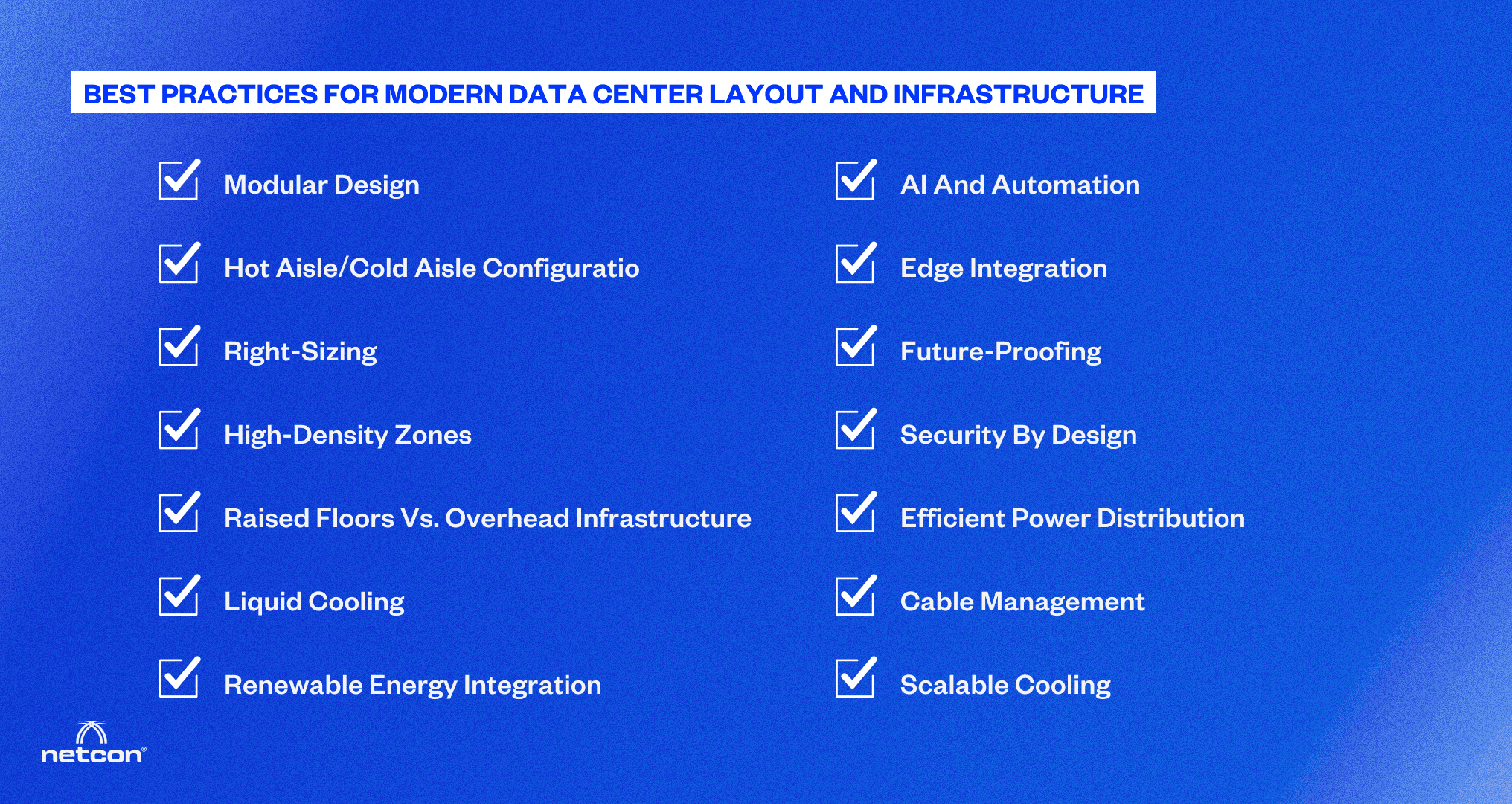
Best practice: Implement comprehensive environmental monitoring, including temperature, humidity, and airflow sensors throughout your data center.
How Netcon Technologies Can Help
Navigating the complex world of data center design standards and best practices can be overwhelming. That's where we come in.
At Netcon Technologies, we're not just up to date on the latest standards and practices - we help shape them. Our team of experts brings decades of collective experience to every project.
Here's how we can help:
1. Standards Compliance: We'll ensure your data center meets or exceeds relevant industry standards.
2. Best Practice Implementation: We'll apply best practices tailored to your specific needs and constraints.
3. Custom Design Solutions: We'll create a data center design that's uniquely suited to your business requirements.
4. Future-Proofing: We'll help you build a data center that's ready for tomorrow's technologies.
5. Efficiency Optimization: We'll maximize your data center's efficiency, reducing operational costs and environmental impact.
6. Security Integration: We'll design comprehensive security measures to protect your valuable data and infrastructure.
7. Ongoing Support: We're with you for the long haul, providing support and guidance as your needs evolve.
Building a data center isn't just about following a set of rules. It's about creating a powerful, efficient, and flexible foundation for your digital operations. It's about turning standards and best practices into a competitive advantage for your business.
Ready to take your data center to the next level? Let's talk. Our team is ready to help you navigate the complexities of data center design and create a facility that doesn't just meet standards - it sets them. Get in touch today, and let's start building the future of your data infrastructure. With Netcon Technologies, you're not just getting a data center - you're getting a partner in your digital success.
Written by
Dr. Sudhakar Gummadi
Director – Consulting Services
Dr. Sudhakar Gummadi holds a Doctorate Degree and 35+ years' expertise to drive business innovation. Specializing in information security, networking, and risk management, he excels in multiplatform enterprise security, compliance, and data centers. His contributions extend to industrial automation, laboratory installations, and teaching post-graduate level courses in Network Engineering, Network Security, and more.

BLOGS
Data Center

Mastering Data Center Management with Expert Consulting
Aug 14, 2024
—
13 min read
Data Center

Engaging with Data Center Consultants for Optimal Solutions
Aug 14, 2024
—
12 min read
Data Center

Introduction to Data Center Certifications: An Overview
Aug 14, 2024
—
14 min read
Data Center

Mastering Data Center Operations with Advanced Certifications
Aug 14, 2024
—
12 min read
Ready to take your company to the next level?
Unlock your business potential with us
Ready to take your company to the next level?
Unlock your business potential with us
Ready to take your company to the next level?
Unlock your business potential with us
Ready to take your company to the next level?
Unlock your business potential with us

© Copyright 2024 Netcon Technologies. All rights reserved. All logos and trademarks used belong to their respective owners.

© Copyright 2024 Netcon Technologies. All rights reserved. All logos and trademarks used belong to their respective owners.

© Copyright 2024 Netcon Technologies. All rights reserved. All logos and trademarks used belong to their respective owners.

© Copyright 2024 Netcon Technologies. All rights reserved. All logos and trademarks used belong to their respective owners.
Ready to take your company to the next level?
Unlock your business potential with us

© Copyright 2024 Netcon Technologies. All rights reserved. All logos and trademarks used belong to their respective owners.
BLOG
Introduction to Data Center Design: Fundamentals and Principles
BY
Dr. Sudhakar Gummadi
—
12
min read


Introduction to Data Center Design: Fundamentals and Principles
Every time you stream a video, send an email, or check your bank balance, you're tapping into the power of a data center. But have you ever wondered what goes on behind those blinking lights and humming servers?
Welcome to the world of data center design. It's a place where cutting-edge technology meets careful planning, where every detail matters, and where the future of our digital lives is being shaped.
In this blog, we're going to pull back the curtain and give you a peek into the fascinating world of data center design. Whether you're a tech enthusiast, a business owner, or just curious about how the internet really works, there's something here for you.
Let's get started with the basics.
Our data centre consulting team can help you optimize your data centre design. Get in touch with us to know more.
Basics of Data Center Design
Think of a data center as a digital city. It needs power, cooling, security, and infrastructure to function. And just like a city, it needs careful planning to run smoothly.
What is Data Center Design and Why is it Important?
Data center design is the art and science of creating the perfect environment for data processing and storage. It's about more than just racks of servers. It's about creating a system that's efficient, reliable, and ready for the future.
Why is it important? Well, let's break it down:
Efficiency: Good design means your data center uses less power and runs more smoothly. That's good for your wallet and good for the planet.
Reliability: In the digital world, downtime is a dirty word. Proper design ensures your data center keeps running, no matter what.
Scalability: The only constant in tech is change. A well-designed data center can grow and adapt as your needs change.
Security: Data is valuable. Good design keeps it safe from both physical and digital threats.
Cost-effectiveness: Smart design can save you money in the long run, reducing operational costs and maximizing your investment.

Think of data center design as the foundation of your digital operations. Get it right, and everything else falls into place. Get it wrong, and you're in for a world of headaches.
Principles of Effective Data Center Design
So, what makes for good data center design? Let's look at some key principles:
1. Flexibility: The tech world moves fast. Your data center needs to keep up. Design with flexibility in mind, so you can adapt to new technologies and changing needs.
2. Scalability: Start small, think big. Your data center should be able to grow with your business. Modular design is your friend here.
3. Efficiency: Power isn't free, and neither is cooling. Design for maximum efficiency to keep your costs down and your performance up.
4. Reliability: Downtime is expensive. Design for redundancy in all critical systems. If one component fails, another should be ready to take over.
5. Security: Data is your most valuable asset. Design your data center with multiple layers of security, both physical and digital.
6. Sustainability: Green is the new black. Design with the environment in mind. It's good for the planet and often good for your bottom line too.
7. Manageability: A data center shouldn't be a maze. Design for easy access and maintenance. Your future self (and your IT team) will thank you.

These principles aren't just theoretical. They're the difference between a data center that's a costly headache and one that's a powerful asset for your business.
Understanding the Basic Data Center Architecture
Now, let's take a look under the hood. What makes up a data center?
1. IT Equipment: This is the heart of your data center. Servers, storage systems, network devices - all the hardware that processes and stores your data.
2. Power Systems: Data centers are power hungry. You need reliable power supply, backup generators, and uninterruptible power supplies (UPS) to keep everything running.
3. Cooling Systems: All that equipment generates heat. Lots of heat. Cooling systems keep everything running at the right temperature.
4. Network Infrastructure: This is how your data center connects to the outside world. It includes routers, switches, and cabling.
5. Security Systems: Both physical (like access controls and surveillance) and digital (firewalls, intrusion detection systems).
6. Fire Suppression: Because nobody wants a barbecued server.
7. Monitoring Systems: To keep an eye on everything and catch problems before they become disasters.
But here's the thing: it's not just about having all these components. It's about how they work together. That's where design comes in.
Let's break down a typical data center layout:
Hot Aisle/Cold Aisle Configuration: This is a smart way to manage airflow. Server racks are arranged in alternating rows, with cold air intakes facing one way and hot air exhausts facing the other. It's like creating traffic lanes for your air conditioning.
Raised Floor: Many data centers use raised floors. The space under the floor can be used for cooling, power distribution, and cabling. It's like giving your data center a basement.
Overhead Cable Trays: Some modern designs are moving away from under-floor cabling and using overhead trays instead. It's easier to access and modify.
Separate Rooms: Most data centers have separate rooms for different functions. There might be a room for IT equipment, another for power systems, and another for cooling equipment. It's like giving each system its own apartment in your data center city.
Loading Dock: Often overlooked, but crucial. You need a way to get equipment in and out safely.
Network Operations Center (NOC): This is the control room of your data center. It's where monitoring and management happen.
Remember, this is just a basic layout. Every data center is unique, designed to meet specific needs and overcome specific challenges.
Data center design is a complex dance of technology, physics, and foresight. It's about creating an environment where your digital operations can thrive, grow, and adapt to whatever the future brings.

But here's the exciting part: we're just scratching the surface. The world of data center design is constantly evolving, with new technologies and approaches emerging all the time.
If you've already reached the next step and are designing your data center, this blog will give you insights and information that'll be valuable to you.
Types of Data Centers
Not all data centers are created equal. Just like cars come in different shapes and sizes for different needs, data centers come in various types. Each type has its own design considerations and is suited for specific purposes. Let's dive in and explore the world of data center diversity.
The Four Main Types of Data Centers Explained
1. Enterprise Data Centers
Think of these as the personal garages of the data center world. They're owned and operated by a single company for its own use.
Who uses them? Large corporations, government agencies, and universities often have their own enterprise data centers.
Design considerations:
- Tailored to the specific needs of the organization
- Often require high levels of security and compliance
- May need to support a wide range of applications and services
Pros:
- Full control over data and infrastructure
- Can be customized to exact specifications
- Often more cost-effective for very large organizations
Cons:
- Requires significant upfront investment
- Organization is responsible for all maintenance and upgrades
2. Colocation Data Centers
These are the apartment buildings of the data center world. Multiple companies rent space in the same facility, bringing their own IT equipment.
Who uses them? Small to medium-sized businesses, larger companies looking for additional capacity or disaster recovery options.
Design considerations:
- Need to accommodate diverse client requirements
- Must have robust security to keep different clients' data separate
- Require scalable power and cooling solutions
Pros:
- Lower upfront costs compared to building your own data center
- Shared infrastructure reduces operational costs
- Professional management and security
Cons:
- Less control over the facility
- Potential for noisy neighbors (other clients' operations affecting yours)
3. Hyperscale Data Centers
These are the skyscrapers of data centers. Massive facilities operated by tech giants to support cloud services.
Who uses them? Companies like Google, Amazon, Microsoft, and Facebook.
Design considerations:
- Enormous power and cooling requirements
- Need for extreme efficiency to manage costs
- Must be highly scalable to accommodate rapid growth
Pros:
- Economies of scale lead to high efficiency
- Cutting-edge technology and design
- Massive computing power and storage capacity
Cons:
- Requires enormous capital investment
- Complex to manage and maintain
- May face regulatory challenges due to their size and power consumption
4. Edge Data Centers
Think of these as the convenience stores of the data center world. Small facilities located close to the users they serve.
Who uses them? Content delivery networks, IoT applications, anyone needing low-latency data processing.
Design considerations:
- Must be compact and efficient
- Often need to operate with minimal on-site staff
- Require robust remote management capabilities
Pros:
- Reduces latency for time-sensitive applications
- Can improve performance and user experience
- Helps manage network congestion
Cons:
- Limited capacity compared to larger data centers
- Can be more expensive to operate due to distributed nature
- May face challenges in terms of physical security and maintenance

Each of these types has its place in the data center ecosystem. The right choice depends on your specific needs, budget, and long-term strategy.
Edge vs. Core Data Centers: Design and Functionality Differences
Now, let's zoom in on two types of data centers that are often compared: Edge and Core. These two represent different approaches to data center design and functionality.
Core Data Centers
Core data centers are the heavy lifters of the data world. They're typically large facilities located in strategic areas, designed to process and store vast amounts of data.
Design Characteristics:
- Large footprint: Often occupy thousands of square feet
- High capacity: Designed to handle massive amounts of data and computing power
- Robust infrastructure: Multiple layers of redundancy in power and cooling
- Centralized: Usually located in areas with good connectivity but not necessarily close to end-users
Functionality:
- Big data processing: Ideal for tasks that require lots of computing power
- Long-term storage: Often used for archiving large amounts of data
- Complex operations: Can handle resource-intensive applications and services
Edge Data Centers
Edge data centers are the sprinters of the data world. They're smaller facilities located closer to end-users, designed for speed and responsiveness.
Design Characteristics:
- Compact size: Often modular or containerized designs
- Distributed: Located in many locations, closer to users
- Efficient cooling: Often use innovative cooling solutions due to space constraints
- Standardized: Tend to use standardized designs for easy replication and management
Functionality:
- Low latency: Ideal for applications that need quick response times
- Local processing: Can handle data processing closer to where data is generated
- Content delivery: Often used to cache and deliver content more efficiently
Key Differences
1. Location and Distribution
Core: Centralized in fewer, larger locations
Edge: Distributed across many smaller locations
2. Size and Capacity
Core: Large facilities with high capacity
Edge: Smaller facilities with limited but focused capacity
3. Latency
Core: Can have higher latency due to distance from users
Edge: Designed for low latency, closer to users
4. Types of Workloads
Core: Suited for big data analytics, long-term storage, complex processing
Edge: Ideal for real-time processing, IoT applications, content delivery
5. Scalability
Core: Scales up (adding more capacity to existing facilities)
Edge: Scales out (adding more edge locations)
6. Management
Core: Often requires significant on-site staff
Edge: Designed for remote management with minimal on-site personnel
7. Cost Structure
Core: High upfront costs, economies of scale in operation
Edge: Lower individual facility costs, but can be more expensive to operate at scale
8. Power Usage
Core: High power usage, but often more efficient due to scale
Edge: Lower power usage per facility, but may be less efficient overall
9. Cooling Solutions
Core: Often uses traditional cooling methods due to available space
Edge: May require innovative cooling solutions due to space constraints
10. Network Architecture
Core: Hub of network architecture
Edge: Extends the network closer to users

The choice between core and edge isn't always an either/or decision. Many organizations are adopting hybrid approaches, using both core and edge data centers to balance performance, cost, and functionality.
Edge computing is growing rapidly, driven by the need for low-latency processing and the explosion of IoT devices. But core data centers aren't going anywhere. They're evolving to handle the massive amounts of data generated by our increasingly digital world.
Understanding these different types of data centers is crucial for making informed decisions about your data infrastructure. Whether you need the raw power of a core data center, the responsiveness of edge computing, or a mix of both, the key is aligning your data center strategy with your business needs.
Need help figuring out what type of data center is right for you? Or maybe you're looking to optimize your existing data center infrastructure? That's where we come in. At Netcon Technologies, we specialize in helping businesses navigate the complex world of data center design and strategy.
Ready to take the next step in your data center journey? Let's talk. Our team of experts is ready to help you find the right data center solution for your unique needs. Get in touch today, and let's start building your data future.
Standards and Best Practices in Data Center Design
In the world of data centers, flying by the seat of your pants isn't an option. Standards and best practices are the guardrails that keep data center design on track. They're the distilled wisdom of countless professionals who've been there, done that, and learned the hard way.
Let's dive into these standards and best practices. They're not just bureaucratic red tape - they're your roadmap to a better, more efficient data center.
Overview of Data Center Design Standards
Standards in data center design aren't just suggestions. They're the benchmark for quality, reliability, and performance. Let's look at some of the key players in the standards game.
1. Uptime Institute Tier Standards
The Uptime Institute's Tier Classification System is the gold standard in data center reliability. It defines four tiers:
Tier I: Basic Capacity
- Single path for power and cooling
- No redundant components
- 99.671% availability
Tier II: Redundant Capacity Components
- Single path for power and cooling
- Redundant components
- 99.741% availability
Tier III: Concurrently Maintainable
- Multiple paths for power and cooling
- Redundant components
- 99.982% availability
Tier IV: Fault Tolerant
- Multiple active paths for power and cooling
- Redundant components
- 99.995% availability

Each tier builds on the previous one, adding layers of redundancy and reliability. But remember, higher tiers come with higher costs. It's about finding the right balance for your needs.
2. TIA-942
This standard from the Telecommunications Industry Association covers everything from site selection to network architecture. It aligns with the Uptime Institute tiers but goes into more detail on telecom infrastructure.
Key areas covered:
- Site space and layout
- Cabling infrastructure
- Reliability levels
- Environmental considerations
3. BICSI 002
The Building Industry Consulting Service International (BICSI) standard is like a detailed cookbook for data center design. It covers:
- Site and space planning
- Power systems
- Cooling systems
- Security
- Network systems
It's particularly useful for its sections on emerging technologies and sustainable design practices.
4. ISO/IEC 22237
This international standard is all about availability, security, and energy efficiency. It's divided into several parts, each focusing on a different aspect of data center design and operation.
Key areas:
- Building construction
- Power distribution
- Environmental control
- Telecommunications cabling infrastructure
- Security systems
5. EN 50600
This European standard is similar to ISO/IEC 22237 but with a European focus. It's particularly strong on energy efficiency and environmental sustainability.

These standards aren't just arbitrary rules. They're based on years of experience and best practices. They help ensure that your data center is reliable, efficient, and ready for the future.
Advanced data center design is the reason behind optimized and well-managed data centers. Read to know more.
Best Practices for Modern Data Center Layout and Infrastructure
Now that we've covered the standards, let's look at some best practices. These are the tricks of the trade that can take your data center from good to great.
1. Modular Design
Think Lego, not monolith. A modular approach allows for:
- Easier scaling
- Phased deployment
- Standardization across multiple sites
Best practice: Design your data center in standardized modules that can be easily replicated or expanded.
2. Hot Aisle/Cold Aisle Configuration
This isn't just a good idea - it's essential for efficient cooling.
How it works:
- Server racks are arranged in alternating rows
- Cold air intakes face one aisle, hot air exhausts face the other
- Containment systems can further improve efficiency
Best practice: Implement hot aisle/cold aisle with containment for maximum cooling efficiency.
3. Right-Sizing
Overprovisioning is costly. Under-provisioning leads to problems down the line.
Best practice: Use data center infrastructure management (DCIM) tools to accurately predict and plan for capacity needs.
4. High-Density Zones
Not all areas of your data center need the same level of cooling or power.
Best practice: Create designated high-density zones for power-hungry equipment, allowing for more targeted cooling and power distribution.
5. Raised Floors vs. Overhead Infrastructure
The debate rages on, but the trend is moving towards overhead infrastructure.
Pros of overhead:
- Easier access for maintenance
- Better for non-uniform rack heights
- Can be more efficient for cable management
Best practice: Consider overhead infrastructure for new builds, but weigh the pros and cons for your specific situation.
6. Liquid Cooling
As power densities increase, air cooling is reaching its limits.
Best practice: For high-density racks (20kW and above), consider liquid cooling solutions.
7. Renewable Energy Integration
Green isn't just good PR - it can also be good for your bottom line.
Best practice: Explore on-site renewable energy options like solar panels or fuel cells, and consider power purchase agreements (PPAs) for off-site renewable energy.
8. AI and Automation
The data center of the future is smart and self-managing.
Best practice: Implement AI-driven management systems for predictive maintenance, energy optimization, and capacity planning.
9. Edge Integration
Edge computing isn't replacing core data centers - it's complementing them.
Best practice: Design your core data center with edge integration in mind. Plan for how data will flow between edge sites and your core facility.
10. Future-Proofing
The only constant in tech is change.
Best practice: Design flexibility into your data center. Use adaptable infrastructure that can accommodate new technologies as they emerge.
11. Security by Design
Security shouldn't be an afterthought.
Best practice: Implement a multi-layered security approach, including physical access controls, surveillance, and cybersecurity measures.
12. Efficient Power Distribution
Power is the lifeblood of your data center. Use it wisely.
Best practice: Implement high-efficiency UPS systems, consider DC power distribution for certain applications, and use intelligent PDUs for granular power monitoring and control.
13. Cable Management
Messy cables aren't just unsightly - they can impede airflow and make maintenance a nightmare.
Best practice: Implement a structured cabling system with clear labeling and routing. Consider fiber optics for high-speed connections.
14. Scalable Cooling
Your cooling needs will change as your data center grows.
Best practice: Implement a scalable cooling system that can adapt to changing heat loads. Consider free cooling where climate permits.
15. Environmental Monitoring
You can't manage what you don't measure.

Best practice: Implement comprehensive environmental monitoring, including temperature, humidity, and airflow sensors throughout your data center.
How Netcon Technologies Can Help
Navigating the complex world of data center design standards and best practices can be overwhelming. That's where we come in.
At Netcon Technologies, we're not just up to date on the latest standards and practices - we help shape them. Our team of experts brings decades of collective experience to every project.
Here's how we can help:
1. Standards Compliance: We'll ensure your data center meets or exceeds relevant industry standards.
2. Best Practice Implementation: We'll apply best practices tailored to your specific needs and constraints.
3. Custom Design Solutions: We'll create a data center design that's uniquely suited to your business requirements.
4. Future-Proofing: We'll help you build a data center that's ready for tomorrow's technologies.
5. Efficiency Optimization: We'll maximize your data center's efficiency, reducing operational costs and environmental impact.
6. Security Integration: We'll design comprehensive security measures to protect your valuable data and infrastructure.
7. Ongoing Support: We're with you for the long haul, providing support and guidance as your needs evolve.
Building a data center isn't just about following a set of rules. It's about creating a powerful, efficient, and flexible foundation for your digital operations. It's about turning standards and best practices into a competitive advantage for your business.
Ready to take your data center to the next level? Let's talk. Our team is ready to help you navigate the complexities of data center design and create a facility that doesn't just meet standards - it sets them. Get in touch today, and let's start building the future of your data infrastructure. With Netcon Technologies, you're not just getting a data center - you're getting a partner in your digital success.
Dr. Sudhakar Gummadi holds a Doctorate Degree and 35+ years' expertise to drive business innovation. Specializing in information security, networking, and risk management, he excels in multiplatform enterprise security, compliance, and data centers. His contributions extend to industrial automation, laboratory installations, and teaching post-graduate level courses in Network Engineering, Network Security, and more.
Read these next


Data Center
Mastering Data Center Management with Expert Consulting
By leveraging the knowledge and experience of seasoned professionals, organizations can transform their data centers from cost centers into strategic assets that drive business growth.
Read now ➝


Data Center
Engaging with Data Center Consultants for Optimal Solutions
From improving energy efficiency and reducing operating costs to enhancing security and planning for future growth, the right consultant can unlock opportunities that drive business value.
Read now ➝


Data Center
Introduction to Data Center Certifications: An Overview
For both data center professionals and the facilities they manage, the lack of industry-recognized certifications can cause a chain reaction of problems. We solve the pain in this blog.
Read now ➝

© Copyright 2024 Netcon Technologies. All rights reserved. All logos and trademarks used belong to their respective owners.

© Copyright 2024 Netcon Technologies. All rights reserved. All logos and trademarks used belong to their respective owners.








